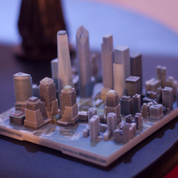Author: Sean Mashian (Downloadable PDF)
 One of the most intriguing, and possibly disruptive, technologies now emerging is 3D printing. While still expensive and relatively unpolished, this new method of manufacturing products – from medical devices to airplanes – could be on a path to revolutionize retail, shipping, and the general need for space. Currently, 3D printing is most often used in the real estate industry as a way of creating scale models for new developments. As the technology grows and becomes more commonplace, there may be huge changes coming to real estate from this emerging technology.
One of the most intriguing, and possibly disruptive, technologies now emerging is 3D printing. While still expensive and relatively unpolished, this new method of manufacturing products – from medical devices to airplanes – could be on a path to revolutionize retail, shipping, and the general need for space. Currently, 3D printing is most often used in the real estate industry as a way of creating scale models for new developments. As the technology grows and becomes more commonplace, there may be huge changes coming to real estate from this emerging technology.
 3D printing may be headed towards the direction of “printing” the real estate itself. In fact, there have already been numerous examples of homes and microhomes being built by a 3D printer. Engineer Alex Le Roux, a graduate student at Baylor University, designed and built a concrete 3D printer that successfully built a small house in 24 hours. This comes on the heels of Shanghai-based Winsun building, a 5-story 3D printed apartment, created at a rate of one floor per day, at a total cost of $160,000. While the structures built so far have been rudimentary in design, many countries have expressed a strong interest in the technology as a way of solving affordable housing issues, primarily in developing countries. The World’s Advanced Saving Project (WASP) recently began experimenting with 3D printing homes in developing areas using local resources, with the resulting village cleverly called a “technological village”. If successul, this method of home building could disrupt the real estate construction industry.
3D printing may be headed towards the direction of “printing” the real estate itself. In fact, there have already been numerous examples of homes and microhomes being built by a 3D printer. Engineer Alex Le Roux, a graduate student at Baylor University, designed and built a concrete 3D printer that successfully built a small house in 24 hours. This comes on the heels of Shanghai-based Winsun building, a 5-story 3D printed apartment, created at a rate of one floor per day, at a total cost of $160,000. While the structures built so far have been rudimentary in design, many countries have expressed a strong interest in the technology as a way of solving affordable housing issues, primarily in developing countries. The World’s Advanced Saving Project (WASP) recently began experimenting with 3D printing homes in developing areas using local resources, with the resulting village cleverly called a “technological village”. If successul, this method of home building could disrupt the real estate construction industry.
 The disruptive nature of 3D printing is not only affecting the way real estate is being built, but also is becoming as prevalent as its 2D counterpart, and could change consumption habits of the average person. Certain asset classes, such as industrial and retail real estate, are likely to see significant changes in demand and neccesity. At a speech to General Electric, global futirist Jack Uldrich raised an excellent question: “What does it mean for the global supply chain when in the near future, instead of printing or producing and manufacturing very sophisticated objects over in Asia, putting them on ships, transporting them across oceans, in the not too distant future, we’re going to be printing very sophisticated objects right in your backyards?” The result will be that, with customizable goods available at relatively low cost, some consumer items will not need to be shipped or stored at all. Massive industrial facilities, for example, will no longer be needed as ports may not be as active. Meanwhile, smaller and medium-sized warehouses, particularily those near population facilities, could benefit from these changes. These smaller industrial properties may take on a new role as quasi-manufacturing plants, as well as fulfillment and storage facilities, allowing consumers to pick up their orders.
The disruptive nature of 3D printing is not only affecting the way real estate is being built, but also is becoming as prevalent as its 2D counterpart, and could change consumption habits of the average person. Certain asset classes, such as industrial and retail real estate, are likely to see significant changes in demand and neccesity. At a speech to General Electric, global futirist Jack Uldrich raised an excellent question: “What does it mean for the global supply chain when in the near future, instead of printing or producing and manufacturing very sophisticated objects over in Asia, putting them on ships, transporting them across oceans, in the not too distant future, we’re going to be printing very sophisticated objects right in your backyards?” The result will be that, with customizable goods available at relatively low cost, some consumer items will not need to be shipped or stored at all. Massive industrial facilities, for example, will no longer be needed as ports may not be as active. Meanwhile, smaller and medium-sized warehouses, particularily those near population facilities, could benefit from these changes. These smaller industrial properties may take on a new role as quasi-manufacturing plants, as well as fulfillment and storage facilities, allowing consumers to pick up their orders.
Right now, 3D printing is expensive and still in rudimentary stages. As we learned from the explosion of e-commerce just a decade ago however, a rapidly growing trend can quickly become a way of life. If 3D printing continues its swift rise to prominence, real estate will change and well-positioned assets stand to benefit.
